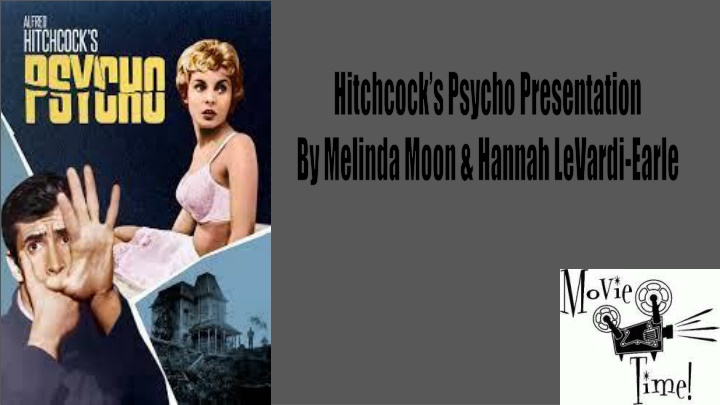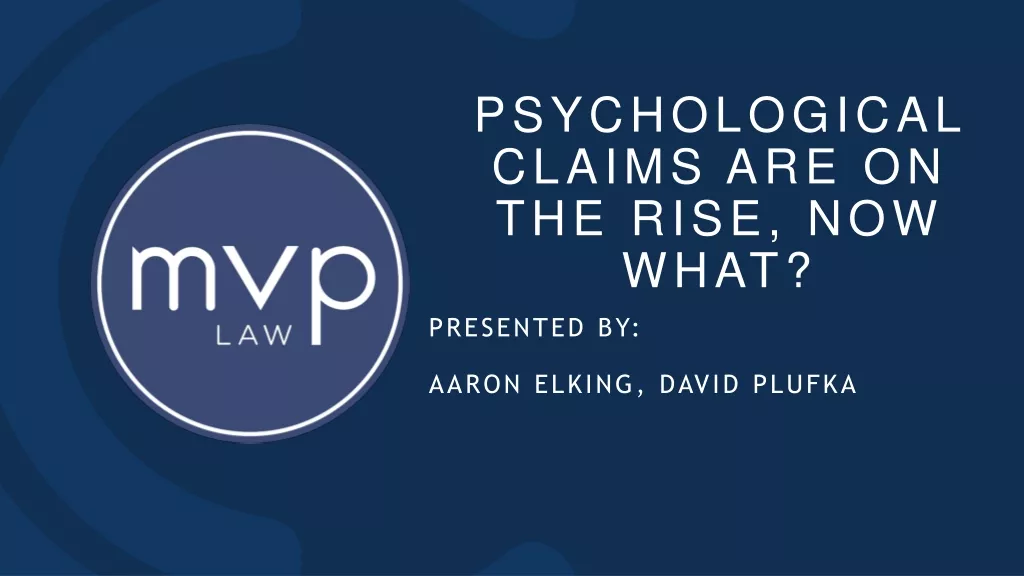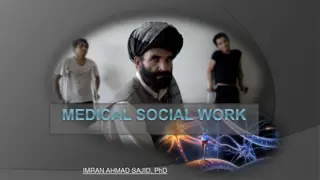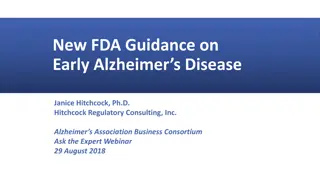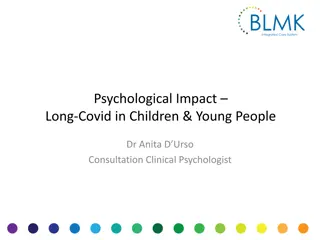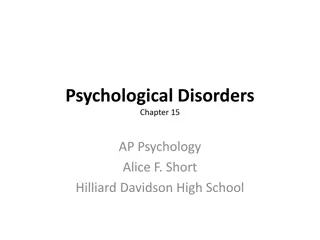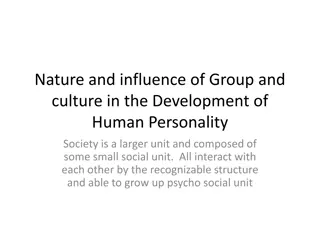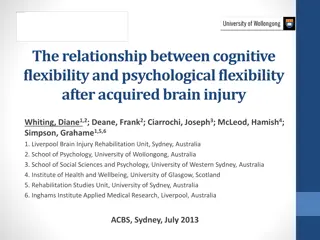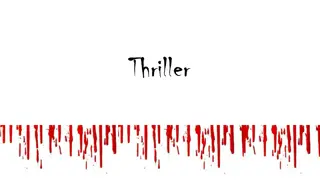Analysis of Themes in Hitchcock's Psycho: A Psychological Thriller
Hitchcock's "Psycho" delves into themes of past influencing the present, abnormal parent-child dynamics, and the unraveling of protagonist Marion Crane's impulsive journey leading to her encounter with Norman Bates. The narrative intricately weaves psychological tension, suspense, and ominous foreshadowing, culminating in Marion's fateful arrival at the Bates Motel. The film masterfully explores the fragility of sanity and the consequences of irrational decisions in a suspenseful and thrilling setting.
Download Presentation

Please find below an Image/Link to download the presentation.
The content on the website is provided AS IS for your information and personal use only. It may not be sold, licensed, or shared on other websites without obtaining consent from the author.If you encounter any issues during the download, it is possible that the publisher has removed the file from their server.
You are allowed to download the files provided on this website for personal or commercial use, subject to the condition that they are used lawfully. All files are the property of their respective owners.
The content on the website is provided AS IS for your information and personal use only. It may not be sold, licensed, or shared on other websites without obtaining consent from the author.
E N D
Presentation Transcript
The Beginning: - The movie opens up with Marion Crane and her long distance love interest Sam. We are automatically introduced to the idea that the couple wants to get married, but due to the financial bind that Sam is in, they have to wait until Sam pays for everything he is debited to. From the article, A leading theme emerges, unexceptional both in itself and in the way in which it is presented; the dominance of the past over the present . Throughout the whole movie, we can easily discover the continuous theme of current events being affected by occurrences from the past. ( we especially see this at the end) Example: Sam wants to wait to marry Marion until he has paid off his dead father's debts and his ex-wife s alimony, so he can provide financial security for Marion. - From the article The whole fabric of this film is interwoven with this parent-child references Examples: Cassidy ( the man with the money ) and his baby , who is his 18-year-old daughter who is about to get married. Norman and his mother Both relations relate to abnormal dynamics. - The scene switches to Marion walking into her long-term real estate assistant job, where her boss brings in a high-paying drunken customer. He drops off $40,000 in cash on Marion's desk, explaining how he was buying off his daughter's unhappiness , with a new house. Instead of listening to her boss s request of dropping the money off at the bank, we witness an anything for love moment. We watch Marion run away with this money like it was nothing, all in order to reach Sam and begin living the life they want to achieve.
What Happens Before The Murder: - At the beginning of her Journey to Sam, the audience early on becomes aware of Marion s impulsive attributes which will carry on with her throughout her short- lived adventure. We can see it in her urgency to get away from the cop who knocks at her window, and in her transaction with the car salesman. Do you think there would be a different ending outcome if the cop had followed and watched Marion all the way to the Bates Motel? - From the article, With her, we lose all power of rational control and discover how easily a normal person can lapse into a condition usually associated with neurosis . ( a relatively mild mental illness that is not caused by organic disease, involving symptoms of stress (depression, anxiety, obsessive behaviour, hypochondria) but not a radical loss of touch with reality. ) - As the audience, we begin to become anxious toward all roadblocks in Marion's way to her final destination, such as the cop following her around, and the hesitant car salesman prolonging her transaction. The eerie dialog that she creates in her head between her and others, adds to an uncomfortable feeling that just worsens as the scenes play out. -
Marion's Arrival to The Bates Motel: As Marion drives on ( after the car exchange of cars) we share her hopelessness and her weariness . - After being trapped in a heavy rainstorm, Marion pulls over to a lonesome and deserted motel, with the only other life presence seeming to be a lady figure seen in the distance through a window. Surprisingly a young man is introduced, and he walks up to the front office introducing himself as Norman Bates, the co-owner of the Bates Motel alongside his ill-minded mother. After expressing her hunger, Norman offers to prepare some food in his kitchen for Marion. After entering her cabin Marion is met with the angered shrieks of a woman yelling at Norman for treating Marion to some food. The person that those shrieks came from, would soon be the same person who murders Marion.
Norman and Marions conversation in the parlor: - From the Article: The confrontation of Marion and Norman Bates is in some ways the core of the film: the parallel made between them provides the continuity that underlies the brutal distributions when Marion is murdered . Between the creepy conversation of Normans taxidermy hobby, and the quick switch to Normans trapped life of being the permanent caregiver of his ill minded mother, we see multiple gears start to turn in Marion s mind. Norman expresses how he has adapted to his trapped lifestyle, which makes Marion realize that she doesn t need to be trapped, and we learn that Marion has plans of traveling back home in the morning. - - From the Article: - Marion is brought face to face with logical extension of her present condition. Norman tells her, We re all in our private trap. We scratch and claw, but only at the air, only at each other, and for all of it we never budge an inch : he is defining the psychotic state the condition of permanent anguish whence development becomes impossible, a psychological hell. The parallel between the two is clinched when Norman says to her, We all go a little mad sometimes. Haven't you? - It is her perception of Norman s condition that gives Marion her chance of salvation, which she takes. In answer to his question, she says, Sometimes just one time can be enough. Thank you. She decides to return the money the next morning. The decision this time is clearly made: she has regained her freedom of will, her power of rationality .
The Film and Article Post Murder: - Hitchcock shifts from the audience sympathizing with Marion and seeing the film through her eyes to sympathizing with Norman and bringing the audience into his psychotic state. This shift suggests that Norman is a continuation of Marion and the audience has shifted into psychosis as well. - The article says, After the murder, Hitchcock uses all resources of identification technique to make us become Norman. - Did you feel as if you were brought into the movie and participating in it, as the article suggests?
Norman: Post Murder - When Norman arrives at Marion s room after the murder is committed, it is obvious that he is in shock and, as is mentioned later on in the film, wakes up from a sleep-like state where the Norman personality has been repressed so that the Mother personality was in complete control. - Norman cleans up the murder scene and gets rid of the body as a means to protect his mother from conviction of the murder. - The article elaborates on how the cinematic direction of the film brings the audience into the clean up and allows the viewers to imagine that they are the ones cleaning up the blood. - As he cleans up after his mother s hideous crime, the camera becomes subjective; they are our hands mopping away the blood Psycho is Hitchcock s ultimate achievement to date in the technique of audience participation.
Norman and Arbogast - Arbogast confronts Norman about Marion being at the motel and notices that Norman is jittery and stutters over his words. He also notices the transition between Norman being adamant that he had not seen Marion to admitting that she was there at one point. This happens after Arbogast examines the ledger and notices a fake name inscribed that could have been an alias that Marion used. - In this scene, one thing that Norman says shows the conflict between personalities. He says to Arbogast that Marion may have fooled him, but she didn t fool his mother.
The Scene between Sam and Norman in the Office: - The article states about the scene where Sam and Norman are speaking to each other across from the desk in the Bates Motel office, As they face each other across the counter of Norman s office, we have the uncanny feeling that we are looking at two sides of the same coin; and the scene in question, which seemed at first mere suspense, useful only in its plot context, becomes one of the most moving of the film. - The gothic idea of the double or doppelganger is evident here. Each man is the opposite of the other, as if one human being s traits are being pulled out and separated into two bodies. The article suggests that all the characters in the film represent one full person. The uncanny double is also very present between the two personalities of Norman and his mother. Each personality taking on specific traits that the other lacks,
Lilas Exploration of the Bates Mansion: - The scene when Lila explores the house has significant influence in the film and sheds light on the way that Norman chooses to express himself and sees himself. The article states that Lila s exploration of the house is an exploration of Norman s psychotic personality. - His mother s room is elaborate and large. He had moved her out of the room but the evidence of her still being there is present. - His room is small and child like. His room is in the attic far away from the large rooms. The bed is messy and he has a small record player. It s as if he never mentally moved on from the time of him being a child. The Norman part of his personality that is left has remained at a child like age and never developed further to allow room for the mother personality to grow.
Lilas Exploration of the Bates Mansion: - When Norman finds Lila in the fruit cellar and she has seen the corpse of his mother, he attacks her and tries to kill her. But he does not do it as himself. He first puts on his mother s dress and a wig. When he is killing he is not doing it as himself, but solely as his mother. This shows the longing for parental protection and love. He believes that he is incapable of being loved and is not allowed to love in order to please his mother. She kills any potential love interest to protect him and to keep him close to her. She does this just as Norman had done it when she had found a lover 10 years previously.
Psychiatrist Scene: - The psychiatrist confirms to the police and Lila that Norman no longer exists in his mind, that his mother s personality has completely taken over. He says, He was never all Norman, but he was often only mother He assumed she was just a jealous of him. Therefore if he felt a strong attraction to any other woman, the mother would go wild. - When the mind houses two personalities, there s always a conflict, a battle. In Norman s case, the battle is over and the dominant personality has won. - In the article: The sense of finality is intolerable, yet it is this that makes our release possible: we have been made to see the dark potentialities within all of us, to face the worst thing in the world: eternal damnation. We can now be set free, be saved for life.
Norman in the Cell at the Police Station: After the mother confesses to the murders of both Marion and Arbogast, and after the psychiatrist elaborately explains the multiple-personality situation that has taken place in Norman s mind, we are brought into the cell where Mother is being kept. She says, They ll put him away now, as I should have years ago. He was always bad.
For Discussion: The scene between Norman and Marion in the parlor: - Norman hesitates to go into Marion s room and instead invites her into the parlor. How does this relate to the sexual untertones of the movie and how the Mother personality is always present in Norman s mind? How does it relate to Marion s desires? Norman says to Marion about leaving his mother, I couldn t do that. Who d look after her? She d be alone up there, the fire would go out and it d be cold and damp like a grave. If you love someone you don t do that, even if you hate them. I don t hate her, I hate what she s become. I hate the illness. -
Idea of the double : - It s obvious that Norman and his Mother represent the idea of the double, but do you think that Marion and Norman could also represent this? - The use of mirrors throughout the film: How does this use of reflections suggest that everyone is a reflection of someone else, or a double of another character in the film? For fun: Here is a short video on the uncanny and double represented in Psycho https://www.youtube.com/watch?v=_FMkGEZP3w0
